|
“The Blind
Girl” is a famous picture painted by an English painter John Everett
Millais. This painting
features a beautiful rainbow that leaves a lasting impression on
those who see it, making it a memorable work of art.
The painting depicts a
tranquil, yet lonely scene of the English countryside. In the
foreground, there is a path with two young female traveling
performers seated on the grass. The elder sister appears to be
blind, while the younger sister sits beside her. Both are dressed in
poverty-stricken clothing.
A forest is shown in the
background, and rising above the trees are two rainbows stretching
across a dark, grayish sky. The colors of the rainbow are strikingly
vivid, standing out in the otherwise somber landscape. The younger
sister looks back at the rainbow, saying something to her elder
sister. However, the blind sister, holding a hand organ on her lap,
stares ahead blankly, unable to witness the beauty of the rainbow.
The painting evokes a deep sense of pity, especially for the blind
girl, who, amidst their poverty and misfortune, cannot even enjoy
the beauty of the rainbow.
There is an interesting
story regarding the two rainbows. Many people may know that when a
bright rainbow appears, a larger, secondary rainbow often forms
above it. When two rainbows are visible, the inner, primary rainbow
is bright, while the outer, secondary rainbow is much fainter. This
is how the rainbows are depicted in Millais's painting. However,
there is another point worth mentioning, which concerns the colors
of the rainbows.
Rainbows are commonly
thought to display the seven colors of the spectrum. The phrase
"seven colors of the rainbow" is familiar to everyone. While the
colors of the rainbow and the spectrum are not exactly the same (a
topic will be discussed later), the primary issue here is that the
color arrangement of the first and second rainbows is reversed. In
the first rainbow, red is on the outside, with violet on the inside,
whereas in the second rainbow, violet is on the outside. This is
true for all rainbows, and there is a reason for this reversal.
When Millais first painted
the work, he mistakenly depicted the second rainbow with red on the
outside, just like the first rainbow. This caused some debate, and
after much discussion, he ended up repainting the second rainbow
with violet on the outside. The version of the painting we see today
is the corrected one.
The fact that the first
rainbow has red on the outside, while the second has violet on the
outside, is something taught in middle school science classes. Some
might find it strange that such a simple mistake could be made.
However, those who think this might not know as much about rainbows
as they assume. The explanation of rainbows in textbooks only
scratches the surface.
Next time you see a rainbow,
take a good, careful look. First, although we often speak of the
"seven colors of the rainbow," in reality, it's rare to see a
rainbow where all seven colors—red, orange, yellow, green, blue,
indigo, and violet—are present in that exact order. More commonly,
the red and yellow bands stand out, while blue is often faint or
even absent. In some cases, the red band is very faint, while the
yellow and green bands are wider, and the red and violet bands are
thinner. The idea of the "seven colors of the rainbow" is different
from the seven colors of the spectrum. The phrase "seven colors" has
led people to mistakenly believe that all rainbows contain the full
sequence of spectral colors, but this is not usually the case.
Anyone who closely observes nature even once will likely notice that
even something as seemingly straightforward as the colors of a
rainbow can provoke doubt. It is natural to question, as these
things are not as simple as they seem.
Now, think back to a time
when you saw a particularly vivid rainbow. You may remember seeing
several weak and narrow rainbow inner part of the primary rainbow.
These extra rainbows often appear doubly or triply in red and green.
This phenomenon is not rare; it can be seen whenever the primary
rainbow is strong. These arcs are an inherent part of the rainbow,
and we might call them "supernumerary rainbows." Supernumerary
rainbows can appear both inside the primary rainbow and outside the
secondary rainbow, although they are often faint and can be hard to
see in the latter case. However, their faintness does not mean they
aren't there—they are just difficult to see due to their low
intensity. Understanding rainbows also requires an explanation of
these supernumerary arcs.
Some observers of
supernumerary rainbows may also notice differences in the brightness
of the sky. The sky inside the primary rainbow is brighter overall,
and the sky outside the secondary rainbow, while darker, is still
somewhat light. Meanwhile, the area between the two rainbows appears
much darker, as if covered with a thin layer of ink. These
variations in brightness are also part of the phenomenon of
rainbows. Just as the beautiful colored rings of the rainbow are
fascinating, so too is the difference in sky brightness. Beauty and
prominence are subjective, human concepts, but from the standpoint
of natural phenomena, the presence of even a single unexplained
anomaly means we do not fully understand the phenomenon.
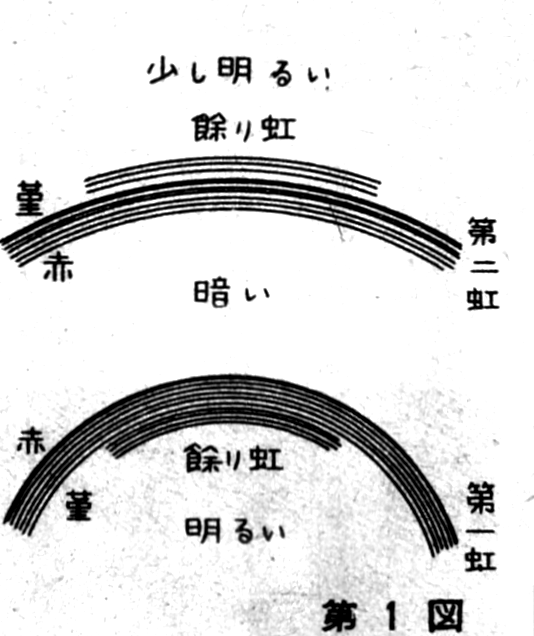
Additionally, there is an
often-overlooked issue with the shape of the rainbow. Textbook
explanations suggest that rainbows should be perfect circles with a
consistent width. However, careful observation reveals that actual
rainbows are sometimes elliptical or slightly distorted. The width
of the rainbow can also vary, not only between different rainbows
but even along the same rainbow. Some parts may be wider, while
others are narrower. One explanation is that the state of the water
droplets causing the rainbow changes depending on their location in
the sky, affecting the shape of the rainbow. However, unless we can
understand exactly how differences in the droplets affect the shape
of the rainbow, this explanation remains incomplete.
I will now attempt to
explain these various phenomena in order, so that readers can
understand that the rainbow, often thought to be a simple and
well-understood phenomenon as depicted even in middle school
textbooks, is in fact far more complex.
Let's begin by explaining
the concept of a rainbow as described in textbooks. A rainbow occurs
when sunlight is reflected and refracted by raindrops, with the
raindrops acting like prisms that break the sunlight into a
spectrum. This is the principle behind a rainbow, and there is no
deviation from this basic principle. However, since the raindrops
responsible for the rainbow are spread across the sky, why does only
a circular band of light appear instead of the entire sky lighting
up? This is the question we will explore first. The issue of color
will be discussed later. If sunlight were composed of just one
color, the rainbow would simply be a circular band of that color.
This can be confirmed through an experiment in which a monochromatic
light, such as yellow light, is used to create a rainbow in a
laboratory, resulting in a yellow rainbow.
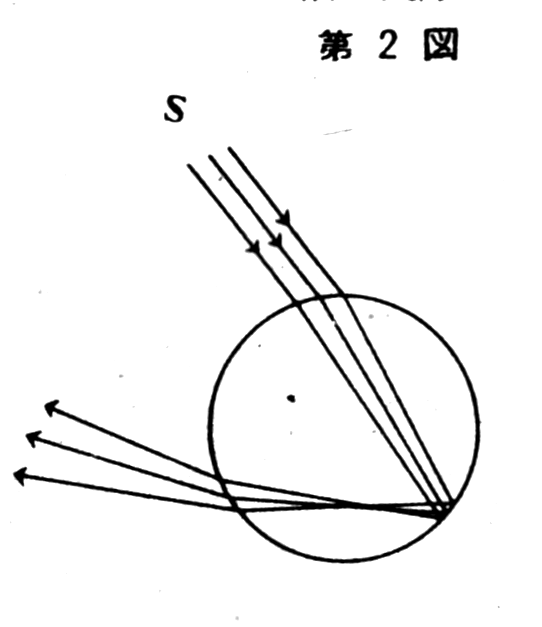
When sunlight hits a water
droplet, part of it is reflected, but most of it is refracted and
enters the droplet. The light is then reflected inside the droplet
and refracted once more as it exits. Figure 2 illustrates the
simplest case of this process. As shown in Figure 2, sunlight
consists of parallel rays, but the light exiting the droplet is not
parallel. If this were the only phenomenon occurring, no rainbow
would form. Since raindrops are scattered throughout the sky, as
shown in Figure 3, light refracted and reflected by droplets in all
directions reaches the observer. Thus, the entire sky would simply
appear bright.
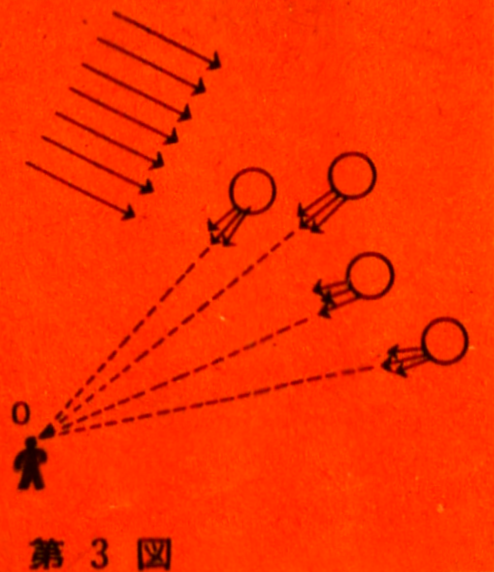
However, according to the
theory of optics, there is a special characteristic when parallel
rays of light are reflected and refracted by water droplets.
Although the light emerging from the droplets is not parallel and
spreads out, the way in which it spreads is not as depicted in
Figure 3. Figure 3 was deliberately drawn incorrectly. When
accurately illustrating the path of light inside and outside a
droplet, it looks like Figure 4. In Figure 4, the ray of light SP
strikes point P on the droplet’s surface and exits in the direction
of RT. The other rays of light—such as rays 1, 2 above SP and 3, 4
below—also exit the droplet in the direction of R. At first glance,
one might assume that rays 1 and 2 should exit above RT and rays 3
and 4 below it, but optics proves this is not the case. Thus, point
P on the droplet’s surface is a special point. The significance of
this special point lies in the angle at which light strikes the
droplet’s surface. The angle between the sphere and the incident
light is determined by the tangent plane at the point where the
light strikes. When the angle between SP and the sphere is a
particular value, the light exits in the direction of RT. Light rays
in the same direction as SP, such as rays 1, 2, 3, and 4, strike the
droplet at angles different from the special angle and are refracted
upwards from the direction of RT. The rays of light exiting the
droplet converge in the upward direction of RT and then scatter, so
more light is concentrated in the direction of RT, making the light
in that direction particularly strong.
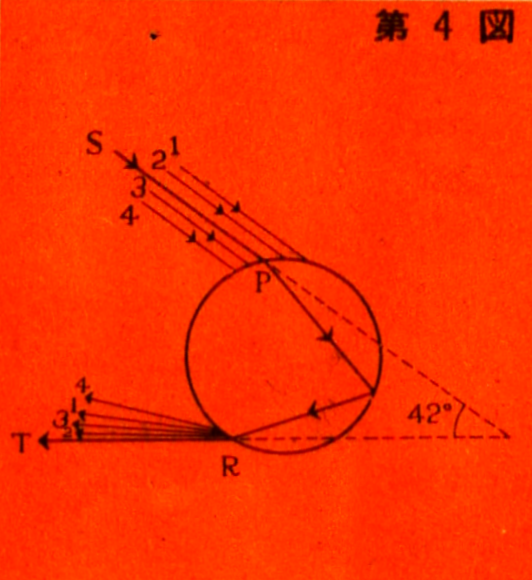
The direction of RT is a
special direction. The angle between this direction and the initial
direction of sunlight is determined solely by the refractive index
of water and is independent of the size of the raindrop. Naturally,
refractive indices vary depending on the substance, and they also
vary based on the wavelength of light, i.e., the color of the light.
When considering the average refractive index of water for the full
wavelength range of sunlight (white light), the refractive index is
1.333. Calculating the angle between SP and the upward direction of
RT in this case yields a value of 42 degrees. This is the angle for
the primary rainbow. When we measure the angle of an actual primary
rainbow, it is found to be approximately 42 degrees, thus confirming
our explanation of the rainbow.
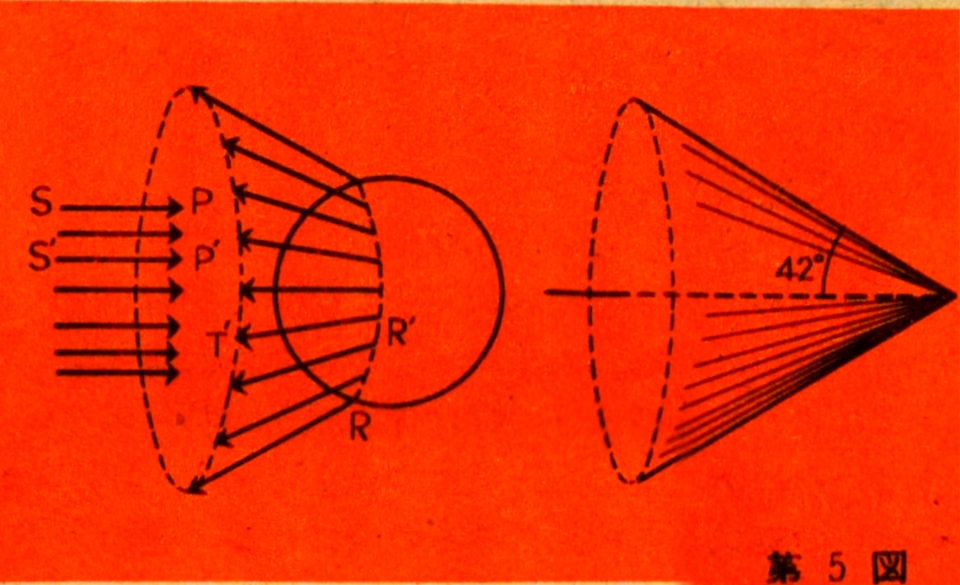
The 42-degree angle of the actual rainbow
requires further explanation. The water droplet, which was
illustrated as a circle in Figure 4, is in reality a sphere. Hence,
the RT direction is three-dimensional, and as shown in Figure 5, the
surface of the cone containing RT becomes the surface where the
light is strongest. The 42-degree angle refers to the angle between
the axis of the cone and the line formed by the cross-section of the
cone's surface. Raindrops are scattered throughout the sky, and each
of them sends light to the surface of the cone, as shown in Figure
5. This is why the human eye perceives a circular rainbow, as shown
in Figure 6. In this diagram, H represents the horizon, O is the
observer, and S is the direction of the sun. The light does not only
come from the raindrops along the arc 1-2-3-4, but from all the
droplets located on the surface of the cone with its apex at point
O. The angle of the rainbow is the sum of the sun’s elevation angle
(a) and the rainbow’s elevation angle (b). This has been
consistently measured to be around 42 degrees, thus confirming our
explanation of the formation of the primary rainbow.
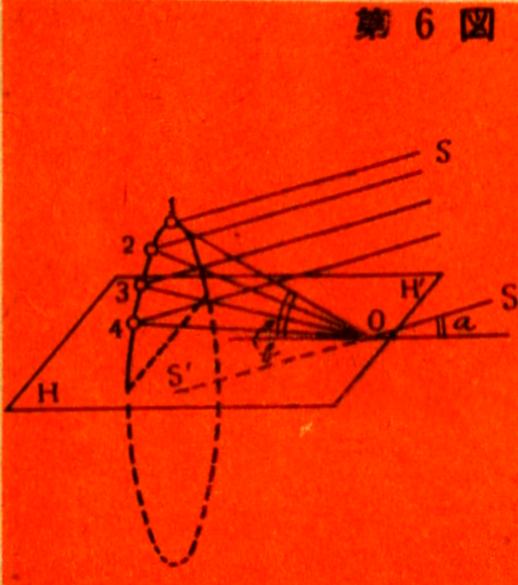
The secondary rainbow can be
explained in much the same way as the primary rainbow. The secondary
rainbow appears outside the primary rainbow, at an angle of
approximately 52 degrees. It is formed by light that reflects twice
inside a water droplet. Figure 7 illustrates the special direction
in which the light exiting the water droplet becomes strong and the
path the light follows. In this case, as with the primary rainbow,
the light rays 1 and 2 above and below the SP line both exit above
the RT line and then move to the underside of the RT line. According
to the theory of optics, the light is strongest when the angle
between the direction of the sunlight and the direction of the light
exiting the droplet is 52.5 degrees. Within this angle, no refracted
light emerges. Since this 52.5-degree angle matches the actual
secondary rainbow, this explanation suffices for the secondary
rainbow as well.
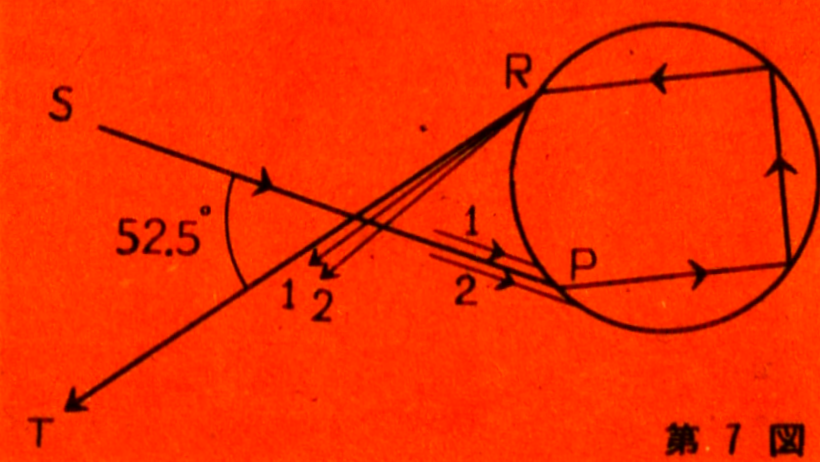
Now, one might wonder if there could also be a
rainbow formed by light reflecting three times inside the droplet.
In fact, such a rainbow does exist, and so do rainbows formed by
four or five reflections. However, calculations show that both the
tertiary and quaternary rainbows form in the direction facing the
sun. Since the sunlight is so strong in that direction, the entire
sky appears bright, obscuring the visibility of the rainbow.
Calculations indicate that the quinary rainbow forms at roughly the
same angle as the secondary rainbow, but the light is so weak that
it is not visible to the human eye. The so-called "supernumerary
rainbows" that occasionally appear near the secondary rainbow are
entirely different from the quinary rainbow.
With this, we have explained
the causes of both the primary and secondary rainbows. However, we
have not yet addressed the issue of how sunlight is broken down into
a spectrum, that is, how rainbows acquire their colors. Let us now
move on to that explanation.
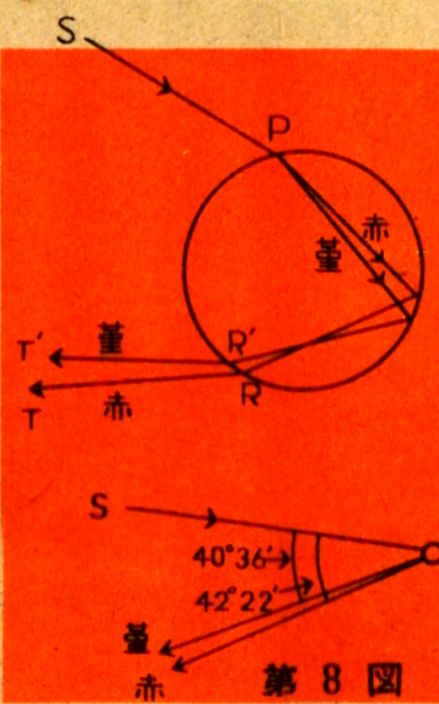
This explanation is
relatively simple. Sunlight is a mixture of seven colors: red,
orange, and so on. Of course, the seven colors are just
representative; in reality, the colors change continuously from red
to violet. For simplicity’s sake, we will refer to them as seven
distinct colors. As mentioned earlier, the refractive index of water
varies depending on the color of the light. For red light, the
refractive index is 1.331, and as the color shifts toward violet,
the refractive index increases, reaching 1.344 for violet light. In
Figure 8, of the mixed light striking point P, the strongest red
light emerges in the direction of RT, while the strongest violet
light emerges in the direction of R’T’. According to calculations
based on the refractive index, red light exits at an angle of 42
degrees 22 minutes, while violet light exits at 40 degrees 36
minutes. For the secondary rainbow, the red light exits at 50
degrees 24 minutes, and the violet light at 53 degrees 36 minutes.
The relationship between the angles of red and violet is reversed in
the secondary rainbow compared to the primary rainbow. This is why
the outer edge of the primary rainbow is red, while the outer edge
of the secondary rainbow is violet.
Because the refractive index
changes in the order of the seven colors of the spectrum, this
explanation implies that the arrangement of colors in any rainbow is
always consistent, with the seven spectral colors appearing in the
same order, and each color maintaining a uniform width across
different rainbows. As shown in Figure 9, the width of the primary
rainbow should always be 1 degree 46 minutes, while the secondary
rainbow should be 3 degrees 12 minutes.
However, as previously
mentioned, actual rainbows often vary in width, sometimes appearing
wider or narrower. In fact, it is rather rare to see a rainbow that
fully displays all seven spectral colors. This discrepancy makes it
clear that the standard explanation found in most textbooks is
insufficient.
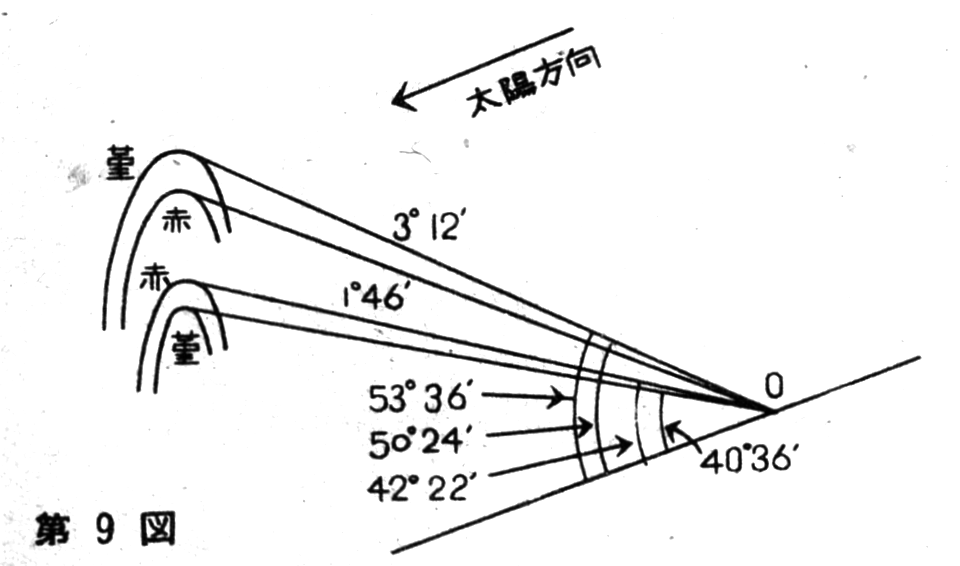
The varying brightness of
the sky, which I mentioned earlier, can actually be explained using
the principles we’ve already covered, even though the differences in
rainbow width and color arrangement present some difficulties. Let’s
address the brightness issue first. In Figure 10, the light exiting
a water droplet is represented by long lines for strong light and
short lines for weak, dispersed light. Let’s consider the water
droplets located inside the primary rainbow. Some of the weak,
dispersed light coming from these droplets will align perfectly with
the right angle and reach point O, as is clear from the diagram.
Since there are countless such droplets inside the primary rainbow,
this area appears uniformly bright. The same applies to the water
droplets outside the secondary rainbow, with their light paths
indicated by dotted lines.
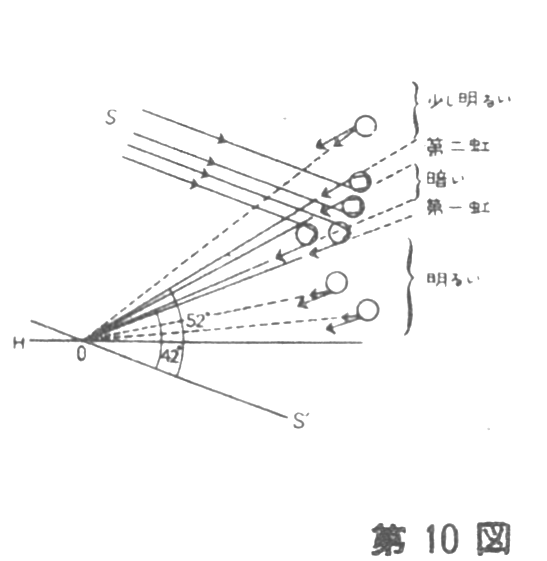 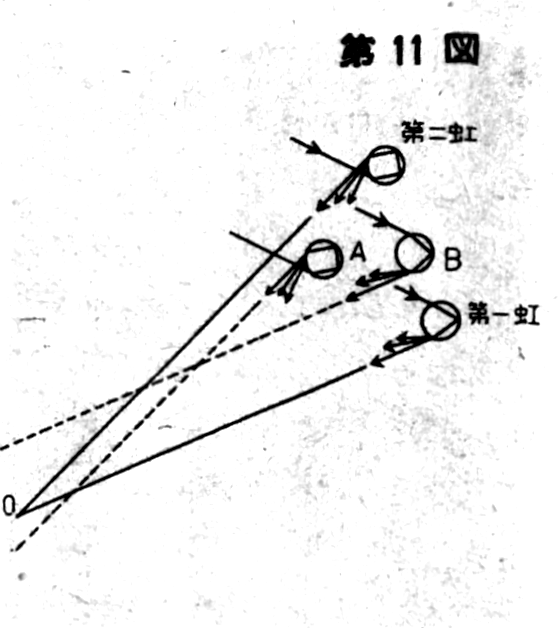
However, the light from the
water droplets situated between the primary and secondary rainbows
cannot reach point O. As seen in Figure 11, the light exiting
droplets A and B, whether strong or weakly dispersed, is directed
away from point O. As a result, no light from this area, including
the weak dispersed light, reaches the observer’s eye through
reflection and refraction, the key principles of rainbow formation.
Therefore, this space between the primary and secondary rainbows
appears much darker compared to other areas. The slight brightness
present is due to the scattering of other light. This explains the
variation in brightness across the sky.
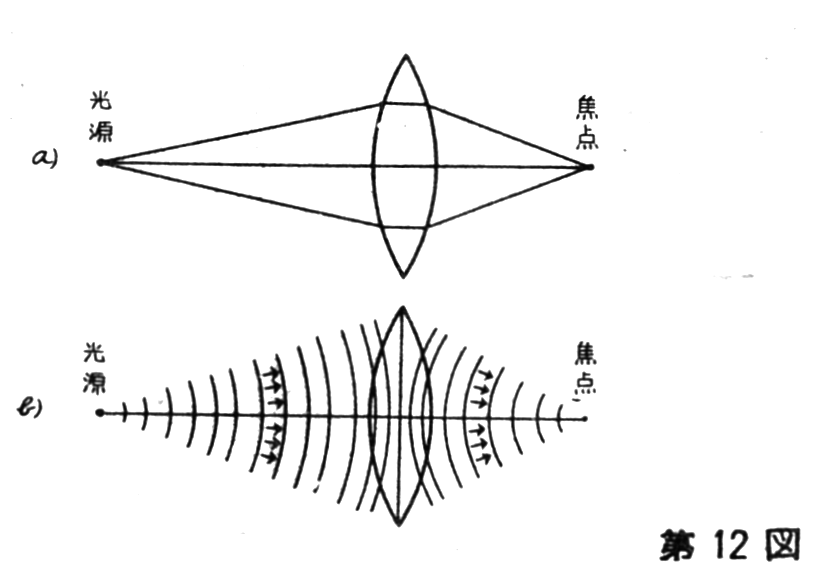
Now we can move on to the
remaining issues: explaining the width and color arrangement of
rainbows, as well as supernumerary rainbows. At this point, we need
to approach the problem from an entirely new perspective. The issue
lies in the fact that up until now, all the light rays in our
explanations have been represented as arrow lines. However, as
everyone knows, light is actually a wave. Thus, to be precise, all
light phenomena must be explained in terms of waves. For example,
the phenomenon of light from a point source forming a focal point
through a lens is usually depicted as in Figure 12(a). However, it
is more accurate to represent it as in Figure 12(b). Even so,
representing the direction of light waves with arrows, which are
perpendicular to the wavefronts, is a simpler way to show the path
of the light wave, and this method suffices in cases like the lens
example. The wavelength of light is shorter than one-thousandth of a
millimeter, so in most cases, the wave nature of light is not a
major issue. However, when water droplets become very small, like
the tiny droplets found in clouds, which are about one-hundredth of
a millimeter, we must take the wave nature of light into account.
In the explanation of
rainbow formation given so far, the size of the water droplets
hasn’t been a significant factor. However, to address the remaining
gaps in this explanation, we must now consider light as a wave.
Supernumerary rainbows, for instance, can be well explained by the
idea that interference occurs when light waves reflect and refract
through small droplets. This interference is what causes
supernumerary rainbows to form.
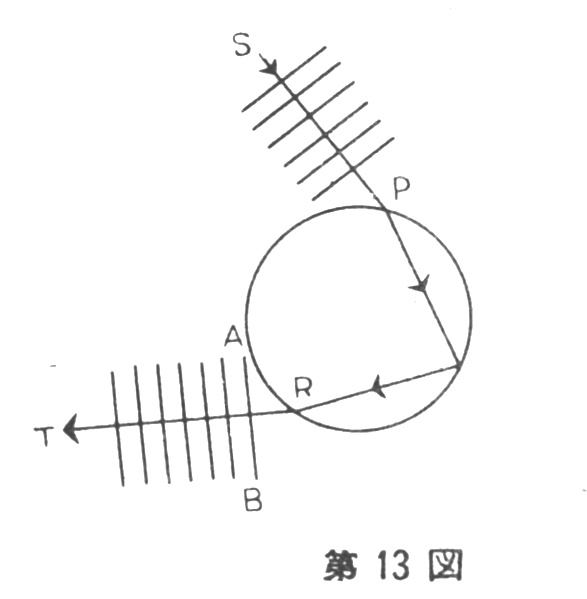
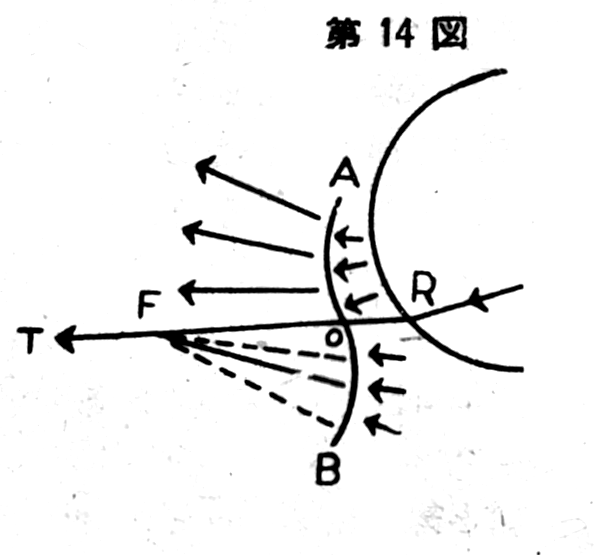
Let’s reconsider the
formation of the primary rainbow by looking at light as a wave. If
we examine only the top lines SP and RT from Figure 4 and overlay
the wavefronts of light, it results in something like Figure 13.
However, this alone reveals nothing new—it merely illustrates that
the wavefronts are parallel and perpendicular to the direction of
light travel.
Now, when the water droplets
are small enough that we can no longer treat the wavelength of light
as negligible compared to the droplet’s radius, a plane wave
entering a droplet as parallel light rays will not emerge as a plane
wave. The wavefront AB in Figure 13 transforms into the curved
surface AOB in Figure 14, according to the wave theory of light. The
curvature of the AOB surface is determined by the droplet's radius
and the refractive index of water. As the droplet’s radius
increases, this curved surface approaches a flat plane. Thus, the
earlier explanations apply only when the water droplets are large.
Between AO, the wavefront is convex, indicating that the light is
diverging, while between OB, the wavefront is concave, meaning the
light is converging. The light in this region should focus at point
F in Figure 15, and beyond F, the light begins to diverge again,
with the wavefront becoming convex. As shown in Figure 15, just
beyond the droplet, there are two wavefronts, O'A' and O'B', and
interference accompanies these double wavefronts.
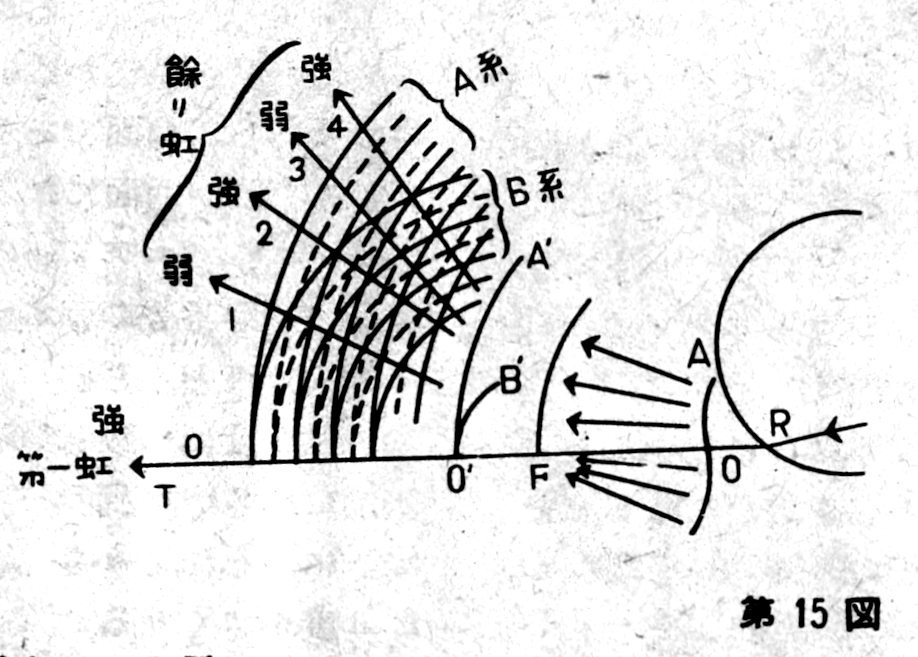
In this context,
interference happens when two waves interact—when a crest overlaps
with a crest, the light strengthens, but when a crest overlaps with
a trough, they cancel each other out, weakening the light. This is
the principle of light interference. In Figure 15, the waves from
systems A and B are depicted with solid lines for crests and dotted
lines for troughs. In the direction above RT, the crests from both
systems overlap, strengthening the light. This is the forward
direction, where light is particularly intense, corresponding to the
conical surface at 42 degrees, as previously explained.
However, there are other
directions, such as 2 and 4 in the diagram, where the interference
also strengthens the light because the crests and troughs align
(solid lines with solid lines, dotted lines with dotted lines).
Conversely, in directions like 1 and 3, where crests and troughs
from different waves overlap, the light is weakened. This
interference causes two or three circular bands of light to appear
just inside the primary rainbow, which are known as supernumerary
rainbows. The light produced by interference weakens as it moves
away from the focal plane, so typically only two or three such bands
are visible, though in rare cases, up to six bands have been
reported.
The above explanation
provides a general overview of interference. More detailed
calculations are required to determine the exact angles for
directions 2 and 4 in Figure 15, as well as whether the direction O
exactly matches the previously discussed 42 degrees. The British
astronomer Airy calculated this and found that the angle for the
primary rainbow is slightly smaller when calculated using wave
theory than when using ray theory. Whether we treat light as rays or
as waves depends on whether the wavefronts emerging from the droplet
are planar or curved, and this curvature occurs when the droplets
are small. Airy’s calculations revealed that in the case of large
droplets, the angle for the brightest part of the rainbow almost
exactly matches the previously mentioned 42 degrees, while for very
small droplets, the angle is about 2 to 3 degrees smaller. Thus, by
treating light as a wave, the size of the droplets becomes a
critical factor for the first time.
This understanding also
allows us to explain why rainbows are not always perfectly circular.
If there are areas of large raindrops in the sky alongside regions
with small cloud droplets, the rainbow can appear slightly irregular
in shape without any problem.
The explanation above became
quite complex, but up to this point, it only covers the behavior of
light in one direction along RT, focusing on monochromatic
(single-color) light. In reality, however, to explain a rainbow, one
must consider the spectrum—red, orange, yellow, and so on—creating
similar diagrams for each color and layering them with slight
directional shifts, as shown in Figure 15. Only after doing this can
we fully explain the rainbow. Yet, even with careful calculation, a
crucial factor still remains unaddressed.
Supernumerary rainbows can
always form within the primary rainbow. However, the angular
distance between the primary rainbow and the first supernumerary
rainbow is key. As mentioned before, the width of the primary
rainbow is 1 degree and 46 minutes. If the gap between the primary
and the first supernumerary rainbow exceeds this width, a strong,
multi-colored primary rainbow will form, followed by a weaker
supernumerary rainbow with seven colors. Usually, two or three such
supernumerary rainbows can be observed. The interference theory
shows that this gap narrows when water droplets are large and widens
when droplets are very small. When the droplets are small, a fully
formed primary rainbow is visible, followed by supernumerary
rainbows inside it.
On the other hand, when the
water droplets are relatively large, the gap between the primary and
the first supernumerary rainbow becomes narrower than the width of
the primary rainbow itself. In such cases, the red part of the
supernumerary rainbow overlaps with the blue part of the primary
rainbow. This raises the question of what happens when different
colors of light overlap. This situation is entirely different from
mixing pigments. For example, when red and green light overlap, the
resulting light is perceived as yellow. Although the wavelengths of
red and green light remain distinct, the human eye perceives them as
yellow when they stimulate the retina simultaneously. If the
intensities of red and green light are appropriately balanced, the
resulting yellow light may appear nearly indistinguishable from
yellow in the spectrum.
Such overlapping phenomena
are surprisingly common in natural rainbows. When the red part of a
supernumerary rainbow overlaps with the green part of the primary
rainbow, that area appears yellow. Since the primary rainbow already
has a yellow section just outside the green area, the yellow part
seems unusually wide. This effect occurs when water droplets are
relatively large. Beautiful rainbows seen after summer showers, for
example, often exhibit this characteristic. Rainbows formed by
larger droplets tend to be clearer and more vibrant. Think of the
brilliant rainbows that sometimes appear after a summer shower—the
red and yellow are striking, while the green and blue sections are
less prominent.
The size of water droplets
varies, leading to differences in the arrangement of rainbow colors.
Therefore, it’s entirely natural for different rainbows to display
varied color patterns. In fact, such variations should be expected.
At this point, we’ve
explained most of the rainbow’s characteristics. When asked why
rainbows form, most people will first mention refraction and
reflection, which is a fine answer. For non-experts, knowing this
much is commendable. However, this explanation alone falls short of
addressing why some rainbows prominently feature only red and
yellow, while green and blue are less noticeable. The failure to
observe real rainbows closely leads to this misconception. Simply
assuming that rainbows consist of seven distinct colors contradicts
the spirit of science.
Nature is incredibly complex
and full of mysteries. Even something as seemingly simple as a
rainbow requires this level of explanation. In fact, many questions
still remain. Only by steadily unraveling such intricate phenomena
can we begin to truly appreciate the beauty of nature.
Some people might say,
"Rainbows are just the result of spectral effects caused by the
refraction and reflection of light in water droplets," and leave it
at that. Such individuals, who don’t bother to observe actual
rainbows, will never truly understand their beauty. They are like
someone who has been blinded not by nature, but by their own
reliance on superficial knowledge. While people naturally sympathize
with someone who physically cannot see the beauty of a rainbow, it
is also unfortunate when people blind themselves to the wonders of
nature by failing to engage with it deeply.
|